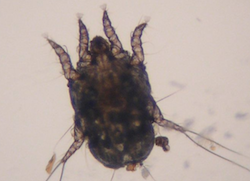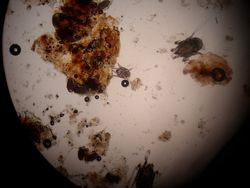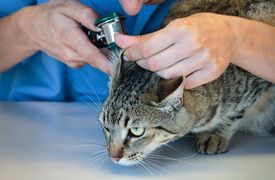Ear scabies
 Ear scabies or otacariose is a condition linked to the presence of an Otodectes cynotis mites in the canals of an animal.
Ear scabies or otacariose is a condition linked to the presence of an Otodectes cynotis mites in the canals of an animal.
It is very common in our domestic carnivores (dog, cat but also ferret).
Who is the Manager ?
The ear scabies parasite is a microscopic mite (less than 0.5 mm) who spent his entire life on the animal it parasite :
He lives on the surface of the ear canal where it feeds on debris of the skin and Earwax and where it breeds. Eggs, larvae and adults are therefore present in the ears of the stray animal (These mites are able to survive only a few days in the external environment).
The entire life cycle of the parasite (passage of the egg to adult) occurs in 3 weeks.
Mites may occasionally come to locate at the level of periauriculaires areas or under the Chin in cats.
Contamination
The transmission the parasite is carried out through direct contact between an animal and an animal infested. It can take place within the same species but a Interspecific contamination (cat dog, the ferret to cat…) is also possible.
It's a highly contagious parasite present particularly in young animals and great staff, communities (livestock, refuge, pet store, cattery, Kennel…)
Symptoms
Some animals, particularly in the ferret, may carry the parasite but asymptomatic, in most cases, symptoms are present :
¤ The presence ofOtodectes cynotis into the ear of an animal is accompanied by significant itching and a sharp pain.
– The animal, very annoyed, frequently shakes her head.
Any attempt to examine the ear is accompanied by a reflex auditopodal (the dog or cat scratching frantically with the rear leg as soon as it touches her ear)
– This very marked scratching can be accompanied by skin lesions sometimes very impressive on the head and especially around the edge of the ears.
It can also cause the appearance of an othematome (a vessel breaks and starts to bleed, forming a pocket of blood between the skin and cartilage of the ear )
¤ Otodectes cynotis is, Furthermore, responsible for an increase in the secretion of ear wax in the ear canal.
– A first blackish and dry Earwax, then more Pasty in the most advanced galls, can very often be noticed in the affected ear.
– This wax is conducive, especially in dogs, otitis surinfectées. Yeast and bacteria then grow into the ear canal and ear wax dark gives way to a purulent.
¤ In the more advanced stages :
– Otitis externa can be complicated to otitis media if it is accompanied by an alteration of the eardrum.
– The inconvenience may be such that the animal guard the head permanently and may suffer from loss of balance.
Diagnosis
Ear scabies diagnosis is done by highlighting by the veterinarian :
– either of the adult parasite directly into the ear with an otoscope
– be adult, larvae or eggs of the parasite under a microscope on a sample of secretions

Adults and eggs of Otodectes cynotis examined by microscopy
When the quantity of parasites present in the ears is important, the diagnosis is easy.
On the other hand, Some animals have a certain"hypersensitivity"Otodectes cynotis. Home, a very low number of mites may cause very marked itching and allergic animal going to self-injure, causing sometimes impressive skin lesions.
The highlight of the parasite will then be much more difficult because :
It is present in very low amounts and therefore hardly detectable
and that symptoms may mimic any allergic disease (pollen allergy, food allergy…)
Treatment
The treatment is to kill parasites :
– Active ear ointments against mites are used
– Cleaning of the ears 2 to 3 twice a week with a cleanser suited must be associated with this treatment.
LL will allow taking off this Earwax in the canals, thus ensuring a mechanical removal of a large amount of parasites as well as a better the acaricide action (It will be directly in contact with the surface of the ear canal and not "flooded" in the dirt)
– Some treatments in spot - there are also active against atrial scabies mites.
It's products containing the selamectin or moxidectin.
These products will be applied at least twice at fifteen days interval
– Knowing that the parasite is very contagious and that asymptomatic carriers may exist, treatment of all individuals in the household is required (dogs, cats, ferrets, even in the absence of clinical signs)
As we have indicated previously, dust mites survive only a few days in the external environment.
– In private homes, a frequent passage of the vacuum cleaner on surfaces in contact with the infested animal will often help clean up the environment.
– In larger numbers, taking into account the high contagiousness of the parasite, capable products to kill dust mites should be used for the cleaning of all surfaces in contact with animals.
§
The introduction of a new pet in a home should always be preceded by a careful review of its canals to ensure that it does not carry mites responsible for scabies of the ears.
The application of a pest control treatment in "spot - on" active against these mites (consult your veterinarian) may also be performed before the newcomer is brought into contact with other animals of his host family, This more if it's an animal that comes from a community or who lived outside.



